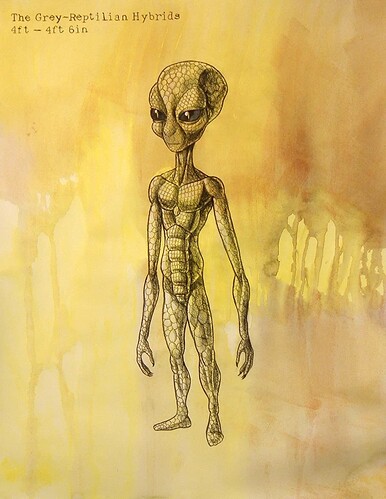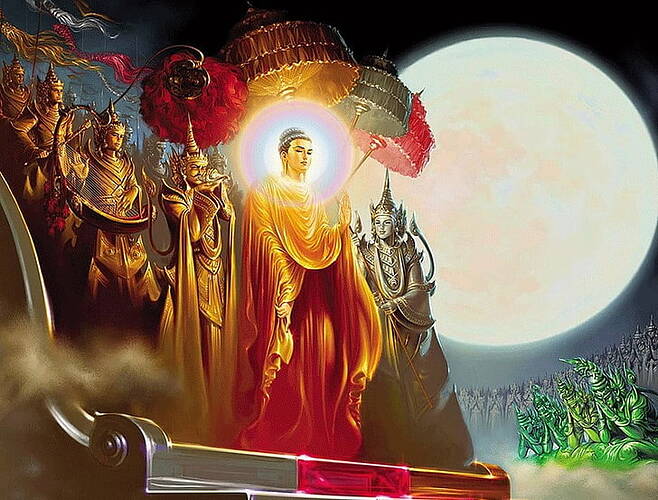Hello friend.
We are all aware of 31 realms of existence. Every realm above human realm is said to be more beautiful than the present one. Human realm is where you can get a ticket to all above realms(heavenly and Brahma realms) and also below realms(lower realms) through deeds.
Buddha was said to be having those 32 signs as mark of superior being and not someone strange being like alien or like that.
How are you so sure that we as humans have highest imaginative capacity and we can imagine things exactly without erring? Just remember your childhood. As a child who just became aware of imagination, our imagination was very rudimentary. It developed as we grew older. Still we are humans. We cannot imagine things perfectly.
If you consider yourself to be able to perfectly imagine things based on just description then off course you will not imagine properly.
Now you forgot read the complete syllabus(80 minor signs) and jumped on rudimentary conclusion of reptilian body structure.
Buddha had 32 major signs of great man along with 80 minor signs of great man. Imagining his body with only 32 signs is like studying half of the syllabus and appearing for exam. Result will be off course failure.
Even having studied the thirty-two signs of a great man, we find that they are not enough to let us explain/imagine all the things related to appearance of lord buddha. What is missing is the following eighty sub-characteristics:
1) beautiful fingers and toes
2) well-proportioned fingers and toes
3) tube-shaped fingers and toes
4) finger- and toenails have rosy tint
5) finger- and toenails slightly upturned at tip (elegant)
6) finger- and toenails smooth & rounded without ridges (not like ours which have lines and rough parts)
7) ankles and wrists rounded and undinted (you don’t see the bones)
8) both feet equal (left and right feet are the same)
9) gait beautiful like a king-elephant
10) gait stately like king-lion
11) gait beautiful like that of a swan
12) gait majestic like royal ox
13) right foot leads when walking (not just a habit, but automatic for him)
14) knees have no (visible) kneecaps (thus there are know kneecaps to be painful when meditating)
15)comportment of a great man
16) navel without blemish
17) deep-shaped abdomen
18) clockwise marks on abdomen (sometimes represented as a swastika on the chest of the Buddha)
19) thighs rounded like banana sheaf (like a Burmese pagoda)
20) both arms shaped like elephant’s trunk (but without the wrinkles)
21) lines on palms have rosy tint
22) skin is thick or thin as it should be
23) skin unwrinkled
24) body spotless and without lumps
25) body unblemished above and below
26) body absolutely free of impurities
27) strength of 1,000 crore elephants or 100,000 crore men (Perhaps you have heard the story of when as a boy the Buddha found an elephant carcase which had been left lying at the side of the path by Devadatta, and which had been cleared to one side by Ananda? Even as a child he could without trouble throw it over the wall by its trunk)
28) protruding nose (more like an Aryan than an Asian)
29) nose well-proportioned
30) upper & lower lips equal in size and have rosy-tint
31) teeth unblemished and with no plaque
32) teeth long like polished conch
33) teeth smooth and unridged
34) all five sense-organs are unblemished
35) all four canine teeth are crystal and rounded
36) face long and beautiful
37) radiant cheeks
38) lines on palms are deep
39) lines on palms are long
40) lines on palms are straight
41) lines on palms are have rosy-tint
42) body has halo of light extending around him for two metres
43) cheek cavity is fully rounded and smooth
44) well-proportioned eyelids
45) five nerves of eyes unblemished (it is said that his eyesight was exceptionally good – he could distinguish a mustard seed in the dark at a distance of 16 kilometres)
46) tips of bodily hair neither curved nor bent
47) rounded tongue
48) tongue soft and with rosy-tint
49) ears long like lotus petals (long – but not so long as depicted in some Buddha images where they flap down over the shoulders)
50) earholes beautifully rounded
51) sinews and tendons don’t stick out anywhere
52) sinews and tendons deeply embedded in flesh
53) topknot is like a crown
54) forehead well-proportioned in length and breadth
55) forehead rounded and beautiful
56) eyebrows arched like a bow
57) fine hair on eyebrows
58) hair of eyebrows lies flat (not like the hair in other places which sticks up)
59) large brows
60) brows reach outward corner of eyes
61) skin fine throughout body
62) whole body abundant with (signs of) fortune
63) body always radiant
64) body always refreshed like a lotus flower
65) body exquisitely sensative to touch
66) scent of body like sandalwood
67) all bodily hair consistent (not in tufts or of different lengths)
68) fine bodily hair
69) breath always fine
70) mouth always beautiful like a smile
71) scent of mouth like a lotus flower (not only the Buddha but also many of his disciples – not like some people who have to use special products such as Listerine to take the unpleasant smell away)
72) hair has the colour of a dark shadow
73) hair is strongly scented
74) hair has the scent of a white lotus
75) curled hair (his hair would always stay the right length for a monk without him having to shave it)
76) hair doesn’t turn grey
77) fine hair
78) untangled hair
79) hair with long curls
80) topknot is as if crowned with flower garland.
Now if you include above 80 signs, you will definitely not reach above conclusion of reptilian image.
Ordinary human’s body is like a plain mountain without any trees or greenary. 32 signs are like mountain with various beautiful trees covering it. 80 signs are like various beautiful nunerou flowers of those trees which further enhance the beauty and majestic ness of that mountain.
Now try to imagine Buddha’s physical appearance with above information. I am 100% sure you will not reach that alien reptilian conclusion which is like a result of child’s imagination.
I will share the link for 80 minor marks -



